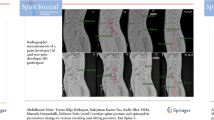Abstract
Background
The sitting position has become the most common posture in today’s workplace. In relation to this position, kinematic analysis of the lumbar spine is helpful in understanding the causes of low back pain and its prevention.
Methods
In this study, we investigated the relationship between sagittal lumbar alignment and pelvic alignment in the standing and sitting positions for 50 healthy adults. Lumbar lordotic angle (LLA), sacral slope (SS), pelvic tilt (PT), and pelvic incidence (PI) were measured on lateral lumbar spine standing and sitting radiographs.
Results
Regarding changes from the standing to sitting positions, average LLA, SS, and PT were −16.6° (−49.8 %), −18.7° (−50.3 %), and 18.3° (284.8 %), respectively (P < 0.01). In the sitting position, lumbar lordosis was reduced and pelvic rotation became posterior.
Conclusions
This study showed that LLA decreased by approximately 50 % and PT increased by approximately 25 % in the sitting position compared with the standing position. No significant gender differences were observed for LLA, SS, and PT in the standing position. In the sitting position, however, LLA and SS were markedly larger for women.

Similar content being viewed by others
References
Kobayashi T, Atsuta Y, Matsuno T, Takeda N. A longitudinal study of congruent sagittal spinal alignment in an adult cohort. Spine (Phila Pa 1976). 2004;29:671–6.
Barrey C, Jund J, Perrin G, Roussouly P. Spinopelvic alignment of patients with degenerative spondylolisthesis. Neurosurgery. 2007;61:981–6.
Endo K, Suzuki H, Tanaka H, Kang Y, Yamamoto K. Sagittal spinal alignment in patients with lumbar disc herniation. Eur Spine J. 2010;19:435–8.
Yoshimoto H, Sato S, Masuda T, Kanno T, Shundo M, Hyakumachi T, Yanagibashi Y. Spinopelvic alignment in patients with osteoarthrosis of the hip: a radiographic comparison to patients with low back pain. Spine (Phila Pa 1976). 2005;30:1650–7.
Offierski C, MacNab I. Hip-spine syndrome. Spine (Phila Pa 1976). 1983;8:316–21.
Okuda T, Fujita T, Kaneuji A, Miaki K, Yasuda Y, Matsumoto T. Stage-specific sagittal spinopelvic alignment changes in osteoarthritis of the hip secondary to developmental hip dysplasia. Spine (Phila Pa 1976). 2007;32:E816–9.
Gelb DE, Lenke LG, Bridwell KH, Blanke K, McEnery KW. An analysis of sagittal spinal alignment in 100 asymptomatic middle and older aged volunteers. Spine (Phila Pa 1976). 1995;20:1351–8.
Mac-Thiong JM, Berthonnaud E, Dimar JR, 2nd, Betz RR, Labelle H. Sagittal alignment of the spine and pelvis during growth. Spine (Phila Pa 1976). 2004;29:1642–7.
Suzuki H, Endo K, Mizuochi J, Kobayashi H, Tanaka H, Yamamoto K. Clasped position for measurement of sagittal spinal alignment. Eur Spine J. 2010;19:782–6.
Vialle R, Levassor N, Rillardon L, Templier A, Skalli W, Guigui P. Radiographic analysis of the sagittal alignment and balance of the spine in asymptomatic subjects. J Bone Jt Surg Am. 2005;87:260–7.
Astfalck RG, O’Sullivan PB, Straker LM, Smith AJ, Burnett A, Caneiro JP, Dankaerts W. Sitting postures and trunk muscle activity in adolescents with and without nonspecific chronic low back pain: an analysis based on subclassification. Spine (Phila Pa 1976). 2010;35:1387–95.
Callaghan JP, McGill SM. Low back joint loading and kinematics during standing and unsupported sitting. Ergonomics. 2001;20(44):280–94.
Epstein JA. Lumbar lordosis: effects of sitting and standing. Spine (Phila Pa 1976). 1998;23:1923.
Keegan JJ. Alterations of the lumbar curve related to posture and seating. J Bone Jt Surg Am. 1953;35-A:589–603.
Lord MJ, Small JM, Dinsay JM, Watkins RG. Lumbar lordosis. Effects of sitting and standing. Spine (Phila Pa 1976). 1997;22:2571–4.
Nachemson A. Disc pressure measurements. Spine (Phila Pa 1976). 1981;6:93–7.
Duval-Beaupère G, Marty C, Barthel F, Boiseaubert B, Boulay C, Commard MC, Coudert V, Cosson P, Descamps H, Hecquet J, Khoury N, Legaye J, Marpeau M, Montigny JP, Mouilleseaux B, Robin G, Schmitt C, Tardieu C, Tassin JL, Touzeau C. Sagittal profile of the spine prominent part of the pelvis. Stud Health Technol Inform. 2002;88:47–64.
De Carvalho DE, Soave D, Ross K, Callaghan JP. Lumbar spine and pelvic posture between standing and sitting: a radiologic investigation including reliability and repeatability of the lumbar lordosis measure. J Manipulative Physiol Ther. 2010;33:48–55.
Philippot R, Wegrzyn J, Farizon F, Fessy MH. Pelvic balance in sagittal and Lewinnek reference planes in the standing, supine and sitting positions. Orthop Traumatol Surg Res. 2009;95:70–6.
Jackson RP, McManus AC. Radiographic analysis of sagittal plane alignment and balance in standing volunteers and patients with low back pain matched for age, sex, and size. A prospective controlled clinical study. Spine (Phila Pa 1976). 1994;19:1611–8.
Wiltse LL, Winter RB. Terminology and measurement of spondylolisthesis. J Bone Jt Surg Am. 1983;65:768–72.
Legaye J, Duval-Beaupère G, Hecquet J, Marty C. Pelvic incidence: a fundamental pelvic parameter for three-dimensional regulation of spinal sagittal curves. Eur Spine J. 1998;7:99–103.
Yoshio M, Murakami G, Sato T, Sato S, Noriyasu S. The function of the psoas major muscle: passive kinetics and morphological studies using donated cadavers. J Orthop Sci. 2002;7:199–207.
Andersson GB, Murphy RW, Ortengren R, Nachemson AL. The influence of backrest inclination and lumbar support on lumbar lordosis. Spine (Phila Pa 1976). 1979;4:52–8.
Takahashi K, Miyazaki T, Takino T, Matsui T, Tomita K. Epidural pressure measurements. Relationship between epidural pressure and posture in patients with lumbar spinal stenosis. Spine (Phila Pa 1976). 1995;20:650–3.
Jackson R, Peterson M, McManus A, Hales C. Compensatory spinopelvic balance over the hip axis and better reliability in measuring lordosis to the pelvic radius on standing lateral radiographs of adult volunteers and patients. Spine (Phila Pa 1976). 1998;23:1750–67.
Conflict of interest
The authors declare that they have no conflict of interest.
Author information
Authors and Affiliations
Corresponding author
About this article
Cite this article
Endo, K., Suzuki, H., Nishimura, H. et al. Sagittal lumbar and pelvic alignment in the standing and sitting positions. J Orthop Sci 17, 682–686 (2012). https://doi.org/10.1007/s00776-012-0281-1
Received:
Accepted:
Published:
Issue Date:
DOI: https://doi.org/10.1007/s00776-012-0281-1




